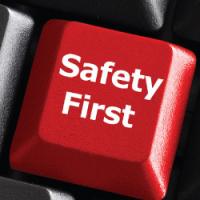- Posts: 350
- Thank you received: 11
Why Safety Belts?
- Safety Toolbox Talk Webmaster
-
 Topic Author
Topic Author - Offline
- Administrator
-

Whether you are driving to work or driving a powered industrial truck at work, safety belt use is important each and every time you get behind the wheel.
Why Safety Belts?
To understand the value of safety belt use, it's important to understand some of the dynamics of a crash. Every motor vehicle crash is actually comprised of three collisions.
The Car's Collision
The first collision is known as the car's collision, which causes the car to buckle and bend as it hits something and comes to an abrupt stop. This occurs in approximately one-tenth of a second. The crushing of the front end absorbs some of the force of the crash and cushions the rest of the car. As a result, the passenger compartment comes to a more gradual stop than the front of the car.
The Human Collision
The second collision occurs as the car's occupants hit some part of the vehicle. At the moment of impact, unbelted occupants are still traveling at the vehicle's original speed. Just after the vehicle comes to a complete stop, these unbelted occupants will slam into the steering wheel, the windshield, or some other part of the vehicle interior. This is the human collision.
Another form of human collision is the person-to-person impact. Many serious injuries are caused by unbelted occupants colliding with each other. In a crash, occupants tend to move toward the point of impact, not away from it. People in the front seat are often struck by unbelted rear-seat passengers who have become high-speed projectiles.
The Internal Collision
Even after the occupant's body comes to a complete stop, the internal organs are still moving forward. Suddenly, these organs hit other organs or the skeletal system. This third collision is the internal collision and often causes serious or fatal injuries.
So, Why Safety Belts? During a crash, properly fastened safety belts distribute the forces of rapid deceleration over larger and stronger parts of the person's body, such as the chest, hips and shoulders. The safety belt stretches slightly to slow your body down and to increase its stopping distance.
The difference between the belted person's stopping distance and the unbelted person's stopping distance is significant. It's often the difference between life and death.
Courtesy of the National Safety Belt Coalition
Please Log in or Create an account to join the conversation.
- Eric F.
-

- Visitor
-

Please Log in or Create an account to join the conversation.
